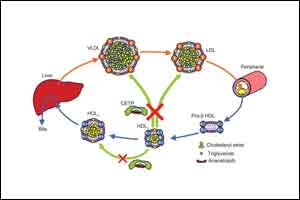- Home
- Editorial
- News
- Practice Guidelines
- Anesthesiology Guidelines
- Cancer Guidelines
- Cardiac Sciences Guidelines
- Critical Care Guidelines
- Dentistry Guidelines
- Dermatology Guidelines
- Diabetes and Endo Guidelines
- Diagnostics Guidelines
- ENT Guidelines
- Featured Practice Guidelines
- Gastroenterology Guidelines
- Geriatrics Guidelines
- Medicine Guidelines
- Nephrology Guidelines
- Neurosciences Guidelines
- Obs and Gynae Guidelines
- Ophthalmology Guidelines
- Orthopaedics Guidelines
- Paediatrics Guidelines
- Psychiatry Guidelines
- Pulmonology Guidelines
- Radiology Guidelines
- Surgery Guidelines
- Urology Guidelines
Anacetrapib (CETP inhibitors) useful in patients with ASCVD: REVEAL Trial

In the, previous trials the CETP inhibitors were found to be ineffective and the trials was stopped around 2 years of follow-up due to unexpected cardiovascular hazards (in the case of torcetrapib) or apparent lack of efficacy (dalcetrapib and evacetrapib).
Anacetrapib is a potent inhibitor of cholesteryl ester transfer protein (CETP) that has been shown to double high-density lipoprotein cholesterol (HDL-C) and lower low-density lipoprotein cholesterol (LDL-C) and has been tried in REVEAL Trial.
The REVEAL trial assessed the safety and efficacy of adding anacetrapib vs. placebo to effective doses of atorvastatin among patients with established occlusive vascular disease.
REVEAL was a randomized, double-blind, placebo-controlled trial that included 30,449 patients with atherosclerotic vascular disease who were receiving intensive atorvastatin therapy. At baseline, mean LDL-C level was 61 mg/dL (1.58 mmol/L), mean non-HDL-C was 92 mg/dL (2.38 mmol/L), and mean HDL-C was 40 mg/dL (1.03 mmol/L).
Participants were randomly assigned to receive either 100 mg anacetrapib once daily or placebo and were followed for a mean of 4.1 years. Both groups were similarly adherent to treatment (90% adherence to randomized treatment at study midpoint). Compliance with statins was 95% in both arms.
Randomization to anacetrapib doubled HDL-C at trial midpoint, increasing it by 43 mg/dL or 104%. Non-HDL-C was decreased by 17 mg/dL or a relative difference of -18% with study treatment. LDL-C was lowered with anacetrapib by -41% (using a direct assay).
During follow-up, the primary endpoint (a composite of coronary death, myocardial infarction, or coronary revascularization) occurred in 10.8% of the anacetrapib arm compared to 11.8% of the placebo arm, yielding a significant 9% proportional reduction (rate ratio, 0.91; p=0.004). Significant reductions were seen in MI alone; the composite of MI or coronary death; and the individual endpoint of coronary revascularization. There was no significant effect on ischemic stroke.
Thus, “The REVEAL trial has demonstrated for the first time that adding anacetrapib to intensive statin therapy with atorvastatin achieves a 9% proportional reduction in major coronary events.
References
- M Landray, Presenter. ESC 2017 Late-Breaking Clinical Trial: HPS3/TIMI 55 – REVEAL: Randomized placebo-controlled trial of anacetrapib in 30,449 patients with atherosclerotic vascular disease. ESC 2017. r 29 AUG 2017.
- The HPS3/TIMI55-REVEAL Collaborative Group.: Effects of Anacetrapib in Patients with Atherosclerotic Vascular Disease. N Engl J Med. 28 Aug 2017. (Published online ahead of print.) 28847206
Dr Prem Aggarwal, (MD, DNB Medicine, DNB Cardiology) is a Cardiologist by profession and also the Co-founder of Medical Dialogues. He is the Chairman of Sanjeevan Hospital in Central Delhi and also serving as the member of Delhi Medical Council

Disclaimer: This site is primarily intended for healthcare professionals. Any content/information on this website does not replace the advice of medical and/or health professionals and should not be construed as medical/diagnostic advice/endorsement or prescription. Use of this site is subject to our terms of use, privacy policy, advertisement policy. © 2020 Minerva Medical Treatment Pvt Ltd